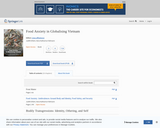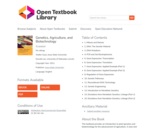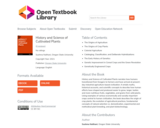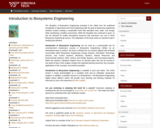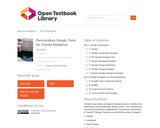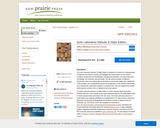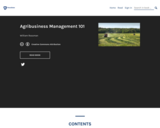
This book has been prepared for students taking Agribusiness Management 101 in The Department of Agricultural Economics, Sociology and Education at The Pennsylvania State University.
Table of Contents:
Lesson 1: Economics as Limits, Alternatives, and Choices
Chapter 1: Introduction
Chapter 1.1 - What Is Economics, and Why Is It Important?
Chapter 1.2 - Confronting Objections to the Economic Approach
Chapter 1.3 - How Individuals Make Choices Based on Their Budget Constraint
Lesson 2: The Market System
Chapter 2: Introduction
Chapter 2.1 - How To Organize Economies: An Overview of Economic Systems
Chapter 2.2 - Introducing the Market System
Chapter 2.3 - The Use of Mathematics in Principles of Economics
Lesson 3: Demand, Supply, and Market Equilibrium Chapter 3
Chapter 3: Introduction
Chapter 3.1 - Demand, Supply, and Equilibrium in Markets for Goods and Services
Chapter 3.2 - Shifts in Demand and Supply for Goods and Services
Chapter 3.3 - Changes in Equilibrium Price and Quantity: The Four-Step Process
Chapter 3.4 - Price Ceilings and Price Floors
Chapter 3.5 - Demand, Supply, and Efficiency
Lesson 4: Market Failures: Public Goods and Externalities
Chapter 4: Introduction
Chapter 4.1 - Why the Private Sector Underinvests in Innovation
Chapter 4.2 - How Governments Can Encourage Innovation
Chapter 4.3 - Public Goods
Lesson 5: Elasticity
Chapter 5: Introduction
Chapter 5.1 - Price Elasticity of Demand and Price Elasticity of Supply
Chapter 5.2 - Polar Cases of Elasticity and Constant Elasticity
Chapter 5.3 - Elasticity and Pricing
Chapter 5.4 - Elasticity in Areas Other Than Price
Lesson 6: Utility Maximization
Chapter 6: Introduction
Chapter 6.1 - Consumption Choices
Chapter 6.2 - How Changes in Income and Prices Affect Consumption Choices
Chapter 6.3 - Indifference Curves
Chapter 6.4 - Behavioral Economics: An Alternative Framework for Consumer Choice
Lesson 7: Production, Costs, and Industry Structure
Chapter 7 : Introduction
Chapter 7.1 - Explicit and Implicit Costs, and Accounting and Economic Profit
Chapter 7.2 - Production in the Short Run
Chapter 7.3 - Costs in the Short Run
Chapter 7.4 - Production in the Long Run
Chapter 7.5 - Costs in the Long Run
Lesson 8 : Pure Competition in the Short Run
Chapter 8 : Introduction
Chapter 8.1 - Perfect Competition and Why It Matters
Chapter 8.2 - How Perfectly Competitive Firms Make Output Decisions
Lesson 9 - Pure Competition in the Long Run
Chapter 9 - Introduction
Chapter 9.1 - Entry and Exit Decisions in the Long Run
Chapter 9.2 - Efficiency in Perfectly Competitive Markets
Lesson 10 - Pure Monopoly
Chapter 10 - Introduction
Chapter 10.1 - How Monopolies Form: Barriers to Entry
Chapter 10.2 - How a Profit-Maximizing Monopoly Chooses Output and Price
Lesson 11: The Demand for Resources
Chapter 11 - Introduction
Chapter 11.1 - Demand for Labor
Lesson 12 - Rent, Interest and Profit
Chapter 12 - Introduction
Chapter 12.1 - Time Value of Money
Lesson 13: Agriculture: Economics and Policy
Chapter 13 - Introduction
Chapter 13.1 - Introduction to the Agriculture Economics
Lesson 14 - International Trade
Chapter 14 - Introduction
Chapter 14.1 - Absolute and Comparative Advantage
Chapter 14.2 - What Happens When a Country Has an Absolute Advantage in All Goods
Chapter 14.3 - Intra-industry Trade between Similar Economies
Chapter 14.4 - The Benefits of Reducing Barriers to International Trade
Chapter 14.5 - Protectionism: An Indirect Subsidy from Consumers to Producers
Chapter 14.6 - International Trade and Its Effects on Jobs, Wages, and Working Conditions
Chapter 14.7 - Arguments in Support of Restricting Imports
Chapter 14.8 - How Governments Enact Trade Policy: Globally, Regionally, and Nationally
Chapter 14.9 - The Tradeoffs of Trade Policy
- Subject:
- Agriculture
- Career and Technical Education
- Economics
- Social Science
- Material Type:
- Textbook
- Author:
- William Rossman
- Date Added:
- 12/11/2020

